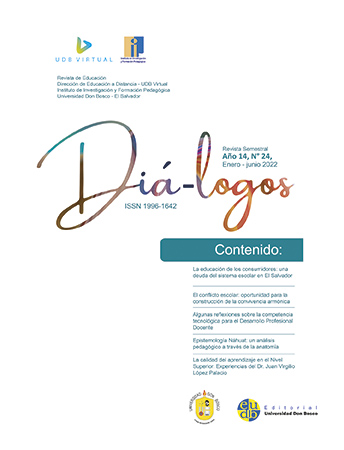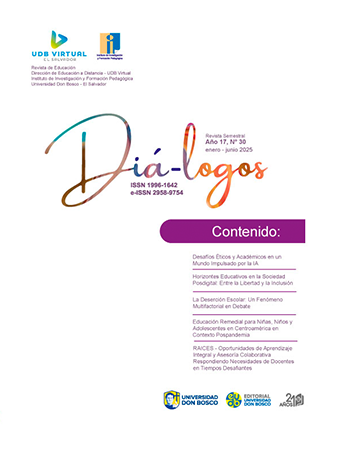Nahuat epistemology: a pedagogical analysis through anatomy
Keywords:
anatomy, epistemology, pedagogy, nahuat, interculturalityAbstract
The text reflects on pedagogy as an educational practice from the Nahuat language. It ventures into cultural diversity in education and the pedagogical systems of indigenous peoples, which is known as interculturality and pedagogy. Thus, it facilitates the incursion of the development of intercultural competencies in educational contexts. The text investigates how the parts of the body relate to philosophical concepts. In this way, the way in which anatomy becomes abstract is delved into, and to do so the following is analyzed: i) a diagram of the body with its parts and names; ii) a review in dictionaries and classical anatomy texts to describe the parts of the body, their literal meaning and then how they correlate to abstract concepts, for example: ma-kwi-l = 5 = hand/grasp/passive, i.e. The hand means “counting” or arithmetic. Another example, yul-tuk = alive = heart-participle = heartbroken, therefore, the heart does not denote only the organ, but the movement of life itself, the vital process of all existence.
Downloads
References
Campbell, L. (1985). The Pipil Language of El Salvador. The Hague: Mouton. Cohen, B. (2010). El cuerpo humano, salud y enfermedad. Wolters Kluwer Health. García-Porrero, J, y Hurlé, J. (2005). Anatomía humana. McGraw-Hill.
De Leon, Lourdes. (1992). Body Parts and Location in Tzotzil: Ongoing Grammaticalization. STUF - Language Typology and Universals. 45 (1) p.570-589. https://doi.org/10.1524/stuf.1992.45.14.570
Delanda, M. (1996). A New Philosophy of Society. Assemblage Theory and Social Complexity. Continuum.
Deleuze, G. y Guattari, F. (1987). Mil mesetas: Capitalismo y Esquizofrenia. Editorial Pre-Textos.
Dibble, C. (1940). Nahuatl Names for Body parts. (1957). Revista de la Sociedad Médica de Historia Natural-Proceedings of the Florida Linguistics Yearly Meeting, (6)1, 27-29.
Hernández, W. (2016). Nawat Mujmusta. Tzunhejekat
Laín Entralgo, P. (2022, 10 de abril). La Anatomía de Vesalio. Biblioteca Virtual Miguel de Cervantes. https://www.cervantesvirtual.com/obra-visor/la-anatomia-de-vesalio/html/4eecce60-1dda-11e2-b1fb-00163ebf5e63_6.html
Lara-Martínez, R. (2010). Mitos en la lengua materna de los Pipiles de Izalco en El Salvador (Traductor e intérprete de Leonhard Schultze-Jena). Universidad Don Bosco. https://amatzin.hypotheses.org/4677
Lara-Martínez, R. (2014). Mitos en la Lengua Materna de los Pipiles de Izalco en El Salvador, Gramática (Leonhard Schultze-Jena). Universidad Don Bosco. https://amatzin.hypotheses.org/4682
Lara-Martínez, R. (21 de abril, 2022). Yul(ta)ketzalis, reflexión sobre el pasado (resumen). DISRUPTIVA, Periodismo, Ciencia y Tecnología. https://www.disruptiva.media/yultaketzalis-reflexion-sobre-el-pasado-resumen/?fbclid=IwAR1A-uRnz0fYcFR8YFVJvNizQzGg4baR6aVLgEOUftQTULaUJfMs-KMlA1M
Lara-Martínez, R. y Molina Aguilar, J. (2022). Epistemología Yulu. Journal de Estudios Multidisciplinarios sobre Derechos Humanos y Ciencias 4 (3). (En prensa).
Launay, M. (1994). Une grammaire omniprédicative. Essai sur la morphosyntaxe du nahuatl classique. CNRS Éditions.
Lehmann, C. (2021). Foundations of body-part grammar. https://www.christianlehmann.eu/publ/lehmann_body.pdf
López, A. y Cuello, E. (2016). La educación intra e intercultural como enfoque pedagógico “propio”. Revista Colombiana de Ciencias Sociales, 7(2), 370-387. https://doi.org/10.21501/22161201.1780.
Organización de las Naciones Unidas para la Educación, la Ciencia y la Cultura UNESCO. (2017). COMPETENCIAS INTERCULTURALES. Marco conceptual y operativo. Cátedra UNESCO - Diálogo intercultural.
Romero Reveron, R. (2007). Andreas Vesalius (1514-1564): Fundador de la Anatomía Humana Moderna. International Journal of Morphology, 25(4), 847-850. http://dx.doi.org/10.4067/S0717-95022007000400026.
Schultze-Jena, L. (1977). Mitos y leyendas de los Pipiles de Izalco. San Salvador: Editorial de la Universidad Don Bosco, 2011. Traducción y notas de Rafael Lara-Martínez. Traducción del alemán de Gloria Menjivar Rieken y Armida Fortín. Ediciones Cuscatlán. https://amatzin.hypotheses.org/2790
Schultze-Jena, L. (1982). Gramática Pipil y Diccionario Analìtico, Tomo 2. Traducción del alemán de Gloria Menjivar Rieken y Armida Fortín. Ediciones Cuscatlán. https://amatzin.hypotheses.org/2806. Rafael Lara-Martínez (Traductor e intérprete), San Salvador: Editorial de la Universidad Don Bosco, 2014.
Speroni, F. (2016). Diccionario de Anatomía e Histología. Universidad Nacional de la Plata. ISBN 978-950-34-1390-6
Tortora, G. y Derrickson, B. (2006). Principios de Anatomía y Fisiología. Editorial Médica Panamericana.
McClintic, R. y McClintic, P. (1976). Manual del estudiante. Anatomía y Fisiología. Limusa.
Mejía, G. (1987). Tradición oral de Concepción de Ataco, Departamento de Ahuachapán, El Salvador (según Miguel Osorio). Dirección del Patrimonio Cultural, Consejo Nacional para la Cultura y el Arte CONCULTURA, Ministerio de Educación.
Mendoza, M. (2019). Spatial Language and the Use of Body-Part Terms in Nahuatl and P’urhepecha. Proceedings of the Florida Linguistics Yearly Meeting 6(1) 37-50. https://journals.flvc.org/floridalinguisticspapers/issue/view/5408
Molina Aguilar, J. (2021). La deconstrucción social del duelo y el horizonte de continuidades. Cuadernos Inter.c.a.mbio sobre Centroamérica y el Caribe, 18(2). https://doi.org/10.15517/c.a..v18i2.4778
Molina Tamacas, C. (2004). Murió Tomás Fidias Jiménez nuestro hombre renacimiento.Biblioteca Nacional de El Salvador.
Museo de la Palabra y la Imagen (20 de abril de 2022). María Mendoza de Baratta: pianista, musicóloga, precursora e investigadora del rescate folklore cuscatleco. https://museo.com.sv/2010/11/biografia-maria-de-baratta/
Wright Carr, D. (2007). Lectura del náhuatl. Fundamentos para la traducción de los textos en náhuatl del periodo Novohispano Temprano. Instituto Nacional de Lenguas Indígenas.
Zahedi, K. (2011). Body parts in language: A cognitive semiosis of human mind- Procedia - Social and Behavioral Sciences, 32, 334-338. https://doi.org/10.1016/j.sbspro.2012.01.049
Published
How to Cite
Issue
Section
License

This work is licensed under a Creative Commons Attribution-NonCommercial-NoDerivatives 4.0 International License.









